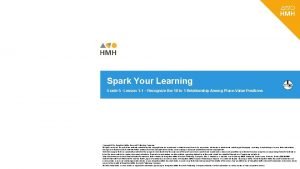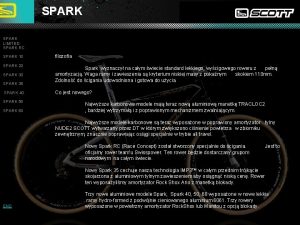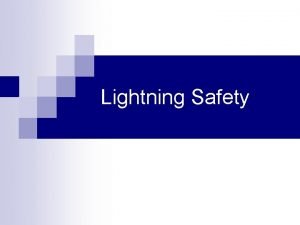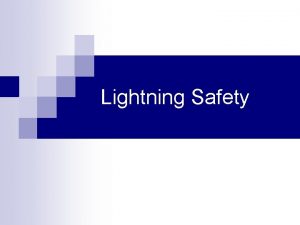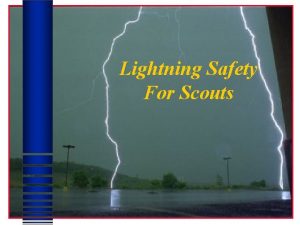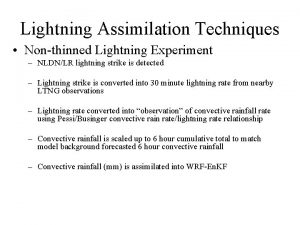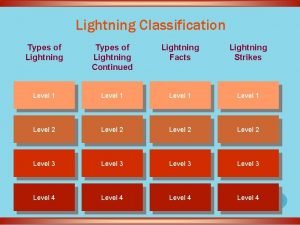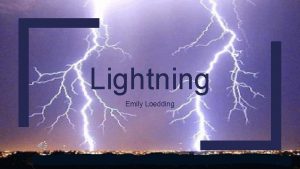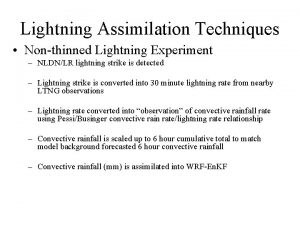Lightning Safety Lightning is a giant spark of


















- Slides: 18

Lightning Safety

Lightning is a giant spark of electricity in the atmosphere between clouds or between a cloud and the ground. It is a dangerous natural force. Lightning strikes can severely injure or kill workers whose jobs involve working outdoors. PPT-SM-LS 2017 2

Lightning can cause injuries in several ways: Direct strike Victims may sustain a direct strike, which is often fatal Occurs when lightning strikes an object the victim is Contact injury touching Occurs when lightning splashes or bounces off an object Side flash onto the victim Occurs when lightning strikes the ground near a victim Ground current and the ground current passes from the strike point through the ground into the victim Bursts of energy can come up from objects near the Streamer ground; sometimes these streamers travel through people Blast injury An injury from lightning’s blast effect, or thunder PPT-SM-LS 2017 3

Lightning injuries include heart attacks, blunt trauma, temporary neurological syndromes, muscle injuries, eye injuries, skin lesions, and burns. PPT-SM-LS 2017 4

Jobs that could potentially expose workers to lightning include: q. Logging q. Explosives handling or storage q. Heavy equipment operation q. Construction q. Plumbing and pipe fitting PPT-SM-LS 2017 5

Workers whose jobs involve working outdoors in open spaces, near tall objects, or on or near explosives or conductive materials are more likely to be exposed to lightning. PPT-SM-LS 2017 6

Your company should train all workers on lightning safety. Supervisors and workers should understand lightning risks, characteristics, and precautions to reduce workplace hazards. Proper planning and safe practices can increase lightning safety when working outdoors. PPT-SM-LS 2017 7

Your company’s emergency action plan should include a written lightning safety protocol, which may include: q How supervisors and workers should take action after they hear thunder, see lightning, or notice any other warning signs of an approaching thunderstorm q How workers are notified about lightning safety warnings q Locations and requirements for safe shelters q How to determine when to suspend and resume outdoor work activities PPT-SM-LS 2017 8

Companies and supervisors should check NOAA weather reports and radio forecasts for all weather hazards before beginning work. OSHA recommends that companies consider rescheduling jobs to avoid workers being caught outside in hazardous weather conditions. PPT-SM-LS 2017 9

When working outdoors, supervisors and workers should continuously monitor weather conditions. Lightning is unpredictable and can strike outside the heaviest rainfall areas or up to 10 miles from any rainfall. PPT-SM-LS 2017 10

If signs of approaching thunderstorms occur, workers should not begin any task they cannot quickly stop. Companies and supervisors should know and tell workers which buildings to go to if they hear thunder or see lightning. PPT-SM-LS 2017 11

NOAA recommends seeking out fully enclosed buildings with electrical wiring and plumbing. If safe building structures are not accessible, companies should guide workers to hard-topped metal vehicles with rolled up windows. Remain in the shelter or vehicle for at least 30 minutes after hearing the last sound of thunder. PPT-SM-LS 2017 12

Do not shelter in sheds, pavilions, tents, or covered porches. They do not provide enough protection. PPT-SM-LS 2017 13

After you hear thunder, do not use corded phones unless it is an emergency. Cell phones and cordless phones can be used safely. PPT-SM-LS 2017 14

Safe practices if you are caught outside during a thunderstorm include: q Seek shelter immediately q Do not lie on the ground or under a tree q Avoid open fields q Retreat to low-lying areas like valleys and ditches; watch for flooding q Stay away from all metal objects, equipment, and surfaces that can conduct electricity PPT-SM-LS 2017 15

If you see someone get struck by lightning, immediately call 911 for help. PPT-SM-LS 2017 16

Lightning is a serious threat to workers who work outdoors. Your company should have a plan in place for what to do during severe weather. Remember, when thunder roars, go indoors. PPT-SM-LS 2017 17

Copyright © 2016 by PEC/Premier Safety Operations, LLC
 Spark sql: relational data processing in spark
Spark sql: relational data processing in spark Safety care behavioral safety training
Safety care behavioral safety training Construction site safety orientation
Construction site safety orientation Personal safety vs process safety
Personal safety vs process safety Ind safety report
Ind safety report Safety depth formula in ecdis
Safety depth formula in ecdis Basic safety orientation
Basic safety orientation Apache spark vs spring
Apache spark vs spring Spark runtime architecture
Spark runtime architecture Logistic regression spark
Logistic regression spark Apache spark mllib
Apache spark mllib Adobe spark examples
Adobe spark examples Adobe certified associate certification programs
Adobe certified associate certification programs Sip gruu
Sip gruu Spark minda starter motor
Spark minda starter motor Chapter 16 to kill a mockingbird summary
Chapter 16 to kill a mockingbird summary Spark your learning
Spark your learning Spark your learning
Spark your learning Apache spark presentation
Apache spark presentation

















